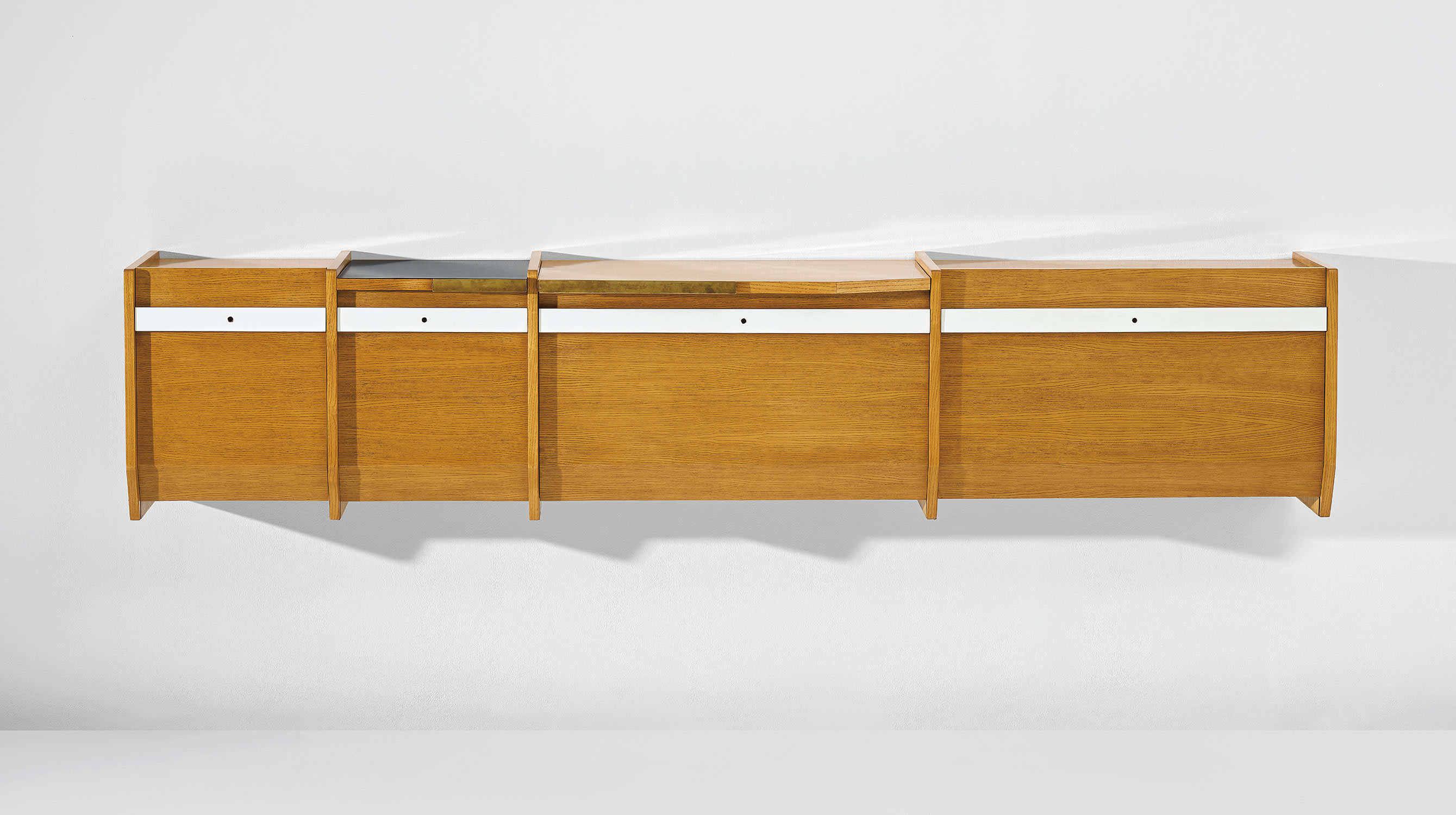

121
Gio Ponti
Illuminated wall-mounted cabinet
Full-Cataloguing
By Brian Kish
This hitherto unknown Gio Ponti commission for Casa P., Milan, comprising lots 116-121, further enriches and expands the canon of this most complex twentieth century Italian architect. Because we can ascertain a 1965 dating from documents, we can conclude that it was likely his very last project for a private domestic interior. By 1964, Ponti was finishing the second of the Hotel Parco dei Principi commissions while coordinating an extensive array of large scale architectural projects: government buildings in Pakistan and Iraq, commercial buildings in Hong Kong and Holland, sacred spaces in Milan and Taranto, and cultural art complexes in Denver, Paris, and Linz. Thus, at that time Ponti was less occupied with apartment spaces than he had been in the preceding four decades. In this 1965 ensemble he returns to earlier schemes, such as the 1936 room at the Milan Triennale. It was there, back in 1936, that he created his ‘demonstration’ room, with meandering wall texts elaborating his thoughts on the new Italian domestic realm, together with ingenious spatial solutions for built-ins or free standing furniture. This was to be his template and a forerunner to the concept of furniture systems, later to be referred to as contract furniture (Lisa Licitra Ponti, Gio Ponti: The Complete Works, London, 1990, p. 83).
By the time of this mature work of the mid 1960s he had begun to reduce his designs to pure colour and form, articulated by expressive tectonic devices. Using black and white laminates Ponti developed what would become his idiosyncratic positivo e negativo tropes. He leaves behind the hermetic and historical concerns characteristic of his production in the 30s and 40s to invent a world of objects imbued with weightless and elegant movement, as seen in the black and white twin set of opened/closed mobile shelf units on delicate brass castors. Elaborate asymmetries can be read in the three wall mounted bookcases, with one unit displaying an extruded singular shelf that engages the lone white horizontal stripe on the front box case of the secondary shelving system, which in turn plays against the smaller shelf unit consisting of only a solitary black box with hovering glass shelves stacked above.
Ponti revisits his 1938 Vanzetti apartment interior, readapting some of its features to the cantilevered sideboard idea. At that time it was divided into four equal parts, but here it is segmented into four parts of varying widths, separated by vertical wooden framing devices that provide an impressive technical solution to obtain an effect akin to levitation. Its two elongated brass handles allow it to be opened from the top, which entertains the client with an unexpected mode of access. Lightness and grace abound in multiple details: the top of the coffee table has an inset strip of black and white laminate set into a field of grey, all supported by hexagonal shaped wooden legs that terminate in brass sabots. In the freestanding sideboard, square handles are smartly recessed into the sliding panels of black or white laminates. These square geometries are in turn bisected by rectangles of alternating black with wood or white with wood, providing results that are both pictorial and wholly abstract. All of these constituent parts add up to playful combinations within these boxes, some are static, some in movement, with their various enclosures alternately sliding back and forth or opening with top lids. The formal unifying principle of recurring interactions between colours and shapes is literally or visually set in motion through asymmetrical relationships, adding up to a scheme, which may recall the ironical researches of Bruno Munari.
At the age of 74, Ponti was still an unmatched creator of custom pieces; he acknowledged the need to work with the best ebanisti for they were the embodiment of excellence and could do justice to his inventions. Some of the ideas from the Casa P. commission were later expanded in Ponti's Apta series of 1970, as well as, in production furniture for Arflex, Sormani, and Tecno. But here, in his last custom design, Ponti achieved clarity coupled with agile poetics to powerful effect.
Gio Ponti
Italian | B. 1891 D. 1979Among the most prolific talents to grace twentieth-century design, Gio Ponti defied categorization. Though trained as an architect, he made major contributions to the decorative arts, designing in such disparate materials as ceramics, glass, wood and metal. A gale force of interdisciplinary creativity, Ponti embraced new materials like plastic and aluminum but employed traditional materials such as marble and wood in original, unconventional ways.
In the industrial realm, he designed buildings, cars, machinery and appliances — notably, the La Cornuta espresso machine for La Pavoni — and founded the ADI (Industrial Designer Association). Among the most special works by Gio Ponti are those that he made in collaboration with master craftsmen such as the cabinetmaker Giordano Chiesa, the illustrator Piero Fornasetti and the enamellist Paolo de Poli.